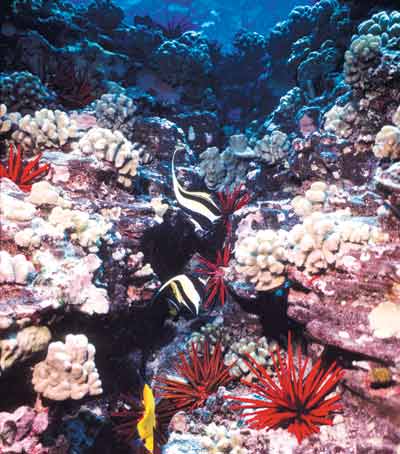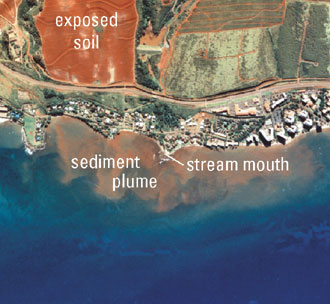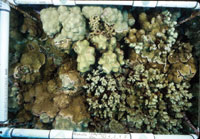Coastal and Marine Geology
U.S.
Geological Survey Fact Sheet 084-01
New Mapping Techniques Help Assess the Health of Hawaii’s Coral Reefs
By
Michael E. Field, Pat S. Chavez, Jr., Kevin R. Evans, and Susan A. Cochran
| More than 60 percent of coral reefs in U.S. waters are found in the extended Hawaiian Island chain. These complex and diverse marine ecosystems are not only ecologically important but also provide hundreds of millions of dollars annually to Hawaii’s economy. Elsewhere in the world, corals are dying at unprecedented rates, and the reefs of Hawaii may also be at risk. To monitor and protect these reefs and to help understand what is threatening coral-reef habitats worldwide, U.S. Geological Survey (USGS) and other scientists are using new techniques to create detailed maps of Hawaii’s coral reefs. |
More than 5,000 square miles
(14,000 km2) of coral reef habitat is found in the Hawaiian Islands from beyond
Midway to the Island of Hawai‘i, constituting more than 60 percent of coral reefs
found in U.S. waters. Hawaii’s reefs are of great importance both
environmentally and economically to those who visit or live on the islands.
These reefs shelter and provide nursery grounds for many commercially and culturally
important species of fish and invertebrates, they protect the islands’
harbors, beaches, and shorelines from erosion and wave damage by storms, and
they are vital to Hawaii’s marine tourism industry. The world’s
coral reefs are home to 25 percent of all marine species, yet it is estimated that
75 percent of these reefs will be destroyed or significantly damaged in the next 20
years. Hawaii’s coral reefs still appear to be relatively healthy,
but some areas of dead and dying coral have been found in recent years. The
causes of this degradation are poorly known, but are probably in part related
to human activities.
 |
| A rich diversity of life inhabits Hawaii’s coral reefs, complex ecosystems that are being affected by both natural processes and human activities. The U.S. Geological Survey is using a combination of techniques to map these reefs in a step toward evaluating their overall health. Photograph copyright, 1998, by Ed Robinson, Hawaiian Watercolors. |
The U.S. Geological Survey
(USGS) is working closely with academic institutions and state and Federal agencies
to assess the factors that affect the health of Hawaii’s and our
Nation’s coral reefs. In order to establish a basis from which scientists
can objectively detect changes in reef health, the USGS and its cooperators
are applying many new techniques to the mapping and monitoring of coral reefs
in Hawaii.
Mapping of coral reefs provides
important information about a number of reef characteristics, such as overall
structure and morphology, abundance and distribution of living coral, and distribution
and types of sediment. No single approach is effective for evaluating the overall
health of a reef. It is only through combining techniques that scientists can
establish the most complete view of a reef, one that can be used for evaluating
reef health and for future monitoring.
New Mapping Techniques
Lidar (light detection and
ranging) is a laser-ranging technique that can penetrate shallow water to depths
as great as 120 feet (36 m) to create precise bathymetric maps that are accurate
to within a few inches (±15 cm). These maps show details of reef structures
and zonations that cannot be revealed using traditional sonar technology, which
requires deeper water for successful operations. Lidar data from the island of
Moloka‘i, digitally combined with aerial photographs, are resulting in
a better understanding of shallow-water coral reef development. Moloka‘i’s
reefs, like many reefs elsewhere in the world, consist of nearshore inner reef
flats that slope to deeper water fore reefs farther offshore. The reef crest,
between the inner reef flat and outer fore reef, lies in extremely shallow water
and may be exposed during the lowest tides. Waves commonly crash against or
break on the reef crest.
Lidar also reveals details
of channels that cross Moloka‘i’s reefs. These channels were originally
valleys formed by streams that cut across and eroded the reefs when sea level
was much lower about 18,000 years ago. The channels across the reefs typically
contain sediment that is a mixture of calcium carbonate (CaCO3) debris (derived
from the breakdown of reef material) and silt and other sediment eroded from
the island. The role of these channels in transporting sediment and their relation
to coral reef health are poorly understood and are one focus of USGS investigations
in Hawaii.
|
MAPPING
CORAL REEF LANDSCAPES
|
|
 |
Many different types of information are gathered to assist in mapping coral reefs. The map (on the left) shows a portion of the coral reef off the south-central shore of the island of Moloka‘i. Very detailed bathymetry (see color scale) was obtained using lidar, a laser-ranging technique that can penetrate shallow water. The oblique perspective view of the same portion of reef (below) was created by digitally draping an aerial photograph on the bathymetric model. By using such detailed maps and images that show prominent features, including channels and large holes, scientists can better understand the structure and development of coral reefs. |
 |
|
 |
Map of the eight main Hawaiian Islands. More than 60 percent of coral reefs in U.S. waters are found in the extended Hawaiian Island chain, which stretches another 950 miles (1,500 km) northwestward from the island of Ni‘ihau to beyond Midway Island. |
Other Mapping and Monitoring
Techniques
Although lidar maps provide
“snapshots” that reveal the large-scale structures of a coral reef,
other techniques provide greater detail on the biological and physical composition
of a reef and can document changes on a scale of months to decades. For example,
large-scale maps showing changes in the distribution of coral, algae, and sediment
are compiled from sequences of aerial photographs taken over decades. Such maps
may show changes that identify groups of coral colonies stressed by sediment
influx or encrusting algal overgrowth.
Hyperspectral imagery, collected
from aircraft, is being used in Hawaii to map coral reefs and potentially
identify areas of dead coral. Hyperspectral imagers measure reflected sunlight
in many narrow wavelengths, ranging from ultraviolet to near infrared. This
spectral information allows for detection of subtle variations in the reef substrate
that are not visible to the naked eye. To calibrate and help interpret the remotely
collected imagery, a hand-held hyperspectral sensor specially outfitted for
underwater data collection is used by divers. The divers collect spectra from
healthy coral colonies, stressed coral colonies, and other sea-floor substrates.
|
MAPPING
CORAL AND SEDIMENT DISTRIBUTION
|
 |
| This oblique aerial photograph (above) shows a portion of the reef tract on Moloka‘i. The map of the same area (right) shows the percentage of live coral and types of sediment. This style of mapping requires direct observations from snorkel and scuba dives. The shoreline in the photo is about 0.7 mile long. |
Another technique being
used by scientists to map coral reefs in Hawaii is acoustic mapping. Dual-frequency
sonar technology is used to map areas of coral reefs in water depths ranging
from 25 feet (8 m) to 120 feet (35 m). By processing data from two frequencies,
it is possible to identify the acoustic signatures of different types of material,
such as soft sediment deposits or hard coral. Observations from scuba dives
are used to help confirm these interpretations.
Scuba and snorkel dives also allow scientists to directly identify coral species and make estimates of living coral coverage and biodiversity. Underwater photography and video transects made by divers provide a record that can be used to map and understand subtle changes in the reef ecosystem. For example, University of Hawai‘i scientists are taking photographs of 1-square-meter plots at selected locations on Hawaii’s reefs to assess changes over time within individual colonies of coral.
 |
 |
|
| A sediment plume obscures the coral reef in this aerial photograph of the western coast of Maui. The sediment was transported by stream runoff from fields where soil is exposed. (Image courtesy of National Oceanic and Atmospheric Administration.) | Growing urbanization and development of coastal areas are a concern for the long-term sustainability of coral reefs. This aerial photograph of Kailua Bay, O‘ahu, shows an area of well-developed and healthy coral reefs. University of Hawai‘i and U.S. Geological Survey scientists are studying these reefs for their role in producing calcareous sand and in protecting beaches from erosion. (Image courtesy of National Oceanic and Atmospheric Administration.) |
 |
 |
| These broad, healthy thickets of the coral Porites compressa thrive in unpolluted, sediment-free water off the southern coast of Moloka‘i. The health of Moloka‘i’s reefs varies locally—other areas appear to show signs of degradation from both natural and manmade causes. Photograph on right shows an unhealthy coral colony off the coast of Moloka‘i that is entangled in an abandoned fishing net. This colony’s productivity is also impaired by suspended sediment that is making the water cloudy or turbid. | |
Historical patterns of sedimentation
are important for determining the role of human activities and their impact
on a coral reef. On shallow reef-flat areas in Hawaii, scientists are
using sediment probes (graduated stainless steel rods) to measure sediment thickness.
Maps of sediment thickness made using these measurements, combined with sediment
ages and compositional data, provide a detailed record of the history of deposition.
Maps of coral reefs help
scientists better understand changes brought about by activities on land. Sediment
eroded from land as a result of both natural processes and human activities
can pose a serious threat to coral reef health by (1) reducing the area of sea
floor suitable for growth of new corals, (2) creating cloudy or turbid water
that diminishes the amount of light available for photosynthesis by symbiotic
algae that live within individual coral animals, and (3) in extreme cases, burying
coral colonies. For example, in the past 100 years, a large amount of sediment
has accumulated on some inner-reef areas of Moloka‘i, and ongoing studies
indicate that this has had an effect on reef health.
 |
 |
| Detailed mapping of coral reefs requires direct observations in the water for identifying coral species and collecting samples. This scientist is documenting changes through time in a group of coral colonies (at right), visited a year earlier, by rephotographing them using a precisely positioned frame. (Photograph on right courtesy of University of Hawai‘i.) | |
Many of the world’s coral reefs already have been severely damaged by human activities. In order to protect and preserve the health of our Nation’s coral reefs, it is essential to monitor these treasured and important ecosystems. Mapping and understanding the history of the coral reefs of Hawaii is a large step toward this goal. The work of USGS scientists studying reefs in Hawaii is only part of the ongoing efforts of the USGS to help protect people’s lives and property from geologic and environmental hazards in the coastal zones of the United States.
Michael E. Field, Pat S. Chavez, Jr., Kevin R. Evans, and Susan A. Cochran
Graphic design
by
Kevin R. Evans and Stephen L. Scott
Web design by Carolyn Donlin
COOPERATING
ORGANIZATIONS
University of Hawai‘i
Hawai‘i Department of Land and Natural Resources
National Oceanic and Atmospheric Administration
National Park Service
University of California Santa Cruz
University of Washington
U.S. Fish and Wildlife Service
For more
information contact:
Coral Reefs Program
U.S. Geological Survey
Pacific Science Center
1156 High Street
Santa Cruz, CA 95064
(831) 427-4745
Download this four-page fact sheet as a PDF document (6.1 MB)
For questions about the content of this report, contact Mike Field
Download a free copy of the latest version of Adobe Reader.
| Help | PDF help | Geopubs main page | Fact Sheets |
| Privacy Statement | Disclaimer |
| Department of the Interior | U.S. Geological Survey | Geologic Division | Marine and Coastal Geology |
Promoting the Health and Sustainability of Coral Reef Habitats